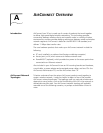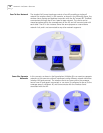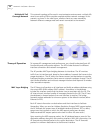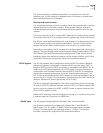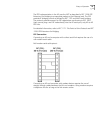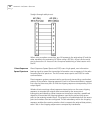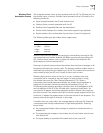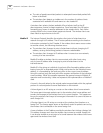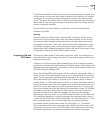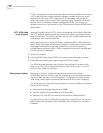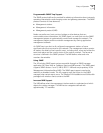
22 A
PPENDIX
A: A
IR
C
ONNECT
O
VERVIEW
The
radio interface
conforms to IEEE 802.11 HR specifications. The interface
operates at 11 Mbps using direct-sequence radio technology. The AP supports
multiple-cell operations with fast, transparent roaming between cells. With the
direct-sequence system, each cell operates independently. Each cell provides a
11 Mbps bandwidth. Adding cells to the network provides increased coverage
area and total system capacity. The AP supports wireless clients operating in
Power
Save Polling
(PSP) mode or
Continuously Aware Mode
(CAM) without user
intervention.
The
DB-9
, 9-pin,
RS-232 serial port
provides a
User Interface
(UI)
or a
Point to Point
Protocol
(PPP
)
connection. The UI provides basic management tools for the AP. The
PPP provides a link between APs using a serial connection. The serial link supports
short haul
(direct serial) or
long haul
(telephone line) connections. The AP is a
Data
Terminal Equipment
(DTE)
device with male pin connectors for the RS-232 port.
Connecting the AP to a PC requires a null-modem cable; connecting the AP to a
modem requires a straight-through cable.
Bridging Support
The AP PPP interface, accessible from the serial port at the rear of the AP, provides
two types of bridging operations:
Internet Protocol
(IP) bridging between an AP
and a computer, and between two APs (with one AP connected to a LAN). To
establish an Internet Protocol bridge with an AP, ensure that the computer
includes the appropriate Telnet software with PPP and TCP/IP protocols. Using
Telnet, a remote computer can connect to any AP on an Ethernet network, as long
as data transfers through IP packets.
A PPP link provides the option of using a direct serial link or modem to extend
wired Ethernet topologies. Once in PPP mode, the AP automatically attempts to
communicate with the other device using the
Data-Link Bridging
(DLB) protocol.
An AP using DLB communicates on the MAC level, and receives and transmits
Ethernet frames.
If the other device does not support DLB, the AP attempts to communicate using
Internet Protocol Control Protocol
(IPCP). An AP using IPCP communicates on the
IP level, and receives and transmits IP
packets.
The PPP implementation in the AP uses the
Link Control Protocol
(LCP) and
Network Control Protocol
(NCP) as described in:
■
RFC 1171: the Point-to-Point Protocol, July 1990
■
RFC 1220: PPP Extensions for Bridging, April 1991
■
RFC 1332: The PPP Internet Protocol Control Protocol, May 1992
■
RFC 1661: The Point-to-Point Protocol, July 1994
(RFCs are
Requests For Comments
used in Internet Communities.)
The AP database dynamically tracks wireless clients and APs on the PPP interface.
Packets forward to the PPP link after the AP determines their destination.






